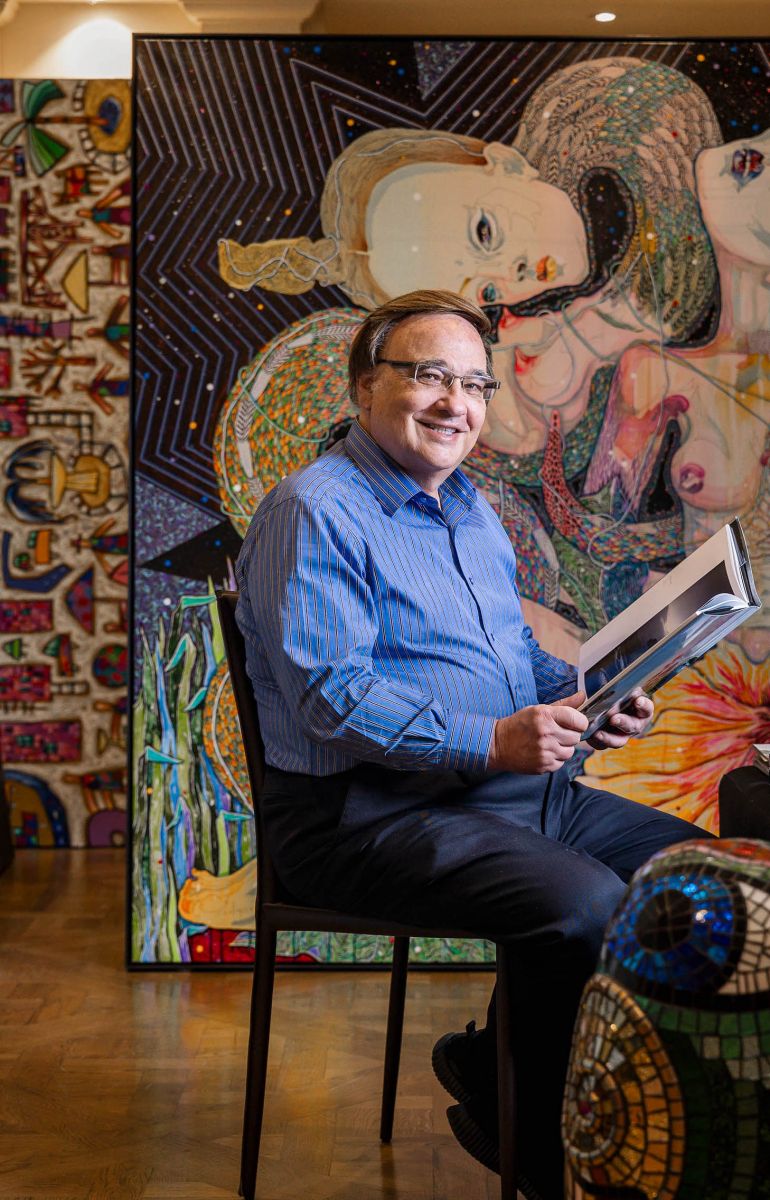A work of art: Meet Melbourne’s favourite art dealer, Irving Laffner
Irving Laffner is not your everyday art dealer. For one, you won’t find him behind the counter at a stark gallery on High Street or Chapel Street. Nor will you ever come across a splashy advertisement with his name in the corner. Rather, he spends his days in a quiet grey house – on a quiet street. In Caulfield North, to be precise. No signboards out front. And certainly, no big canvases gracing his windows. But beauty abounds within. Join us as we tour Irving’s stunning home gallery and learn about his story. Get ready to discover everything from the random moments that brought him to where he is today – to why he thinks it may be hard to pass on his passion.
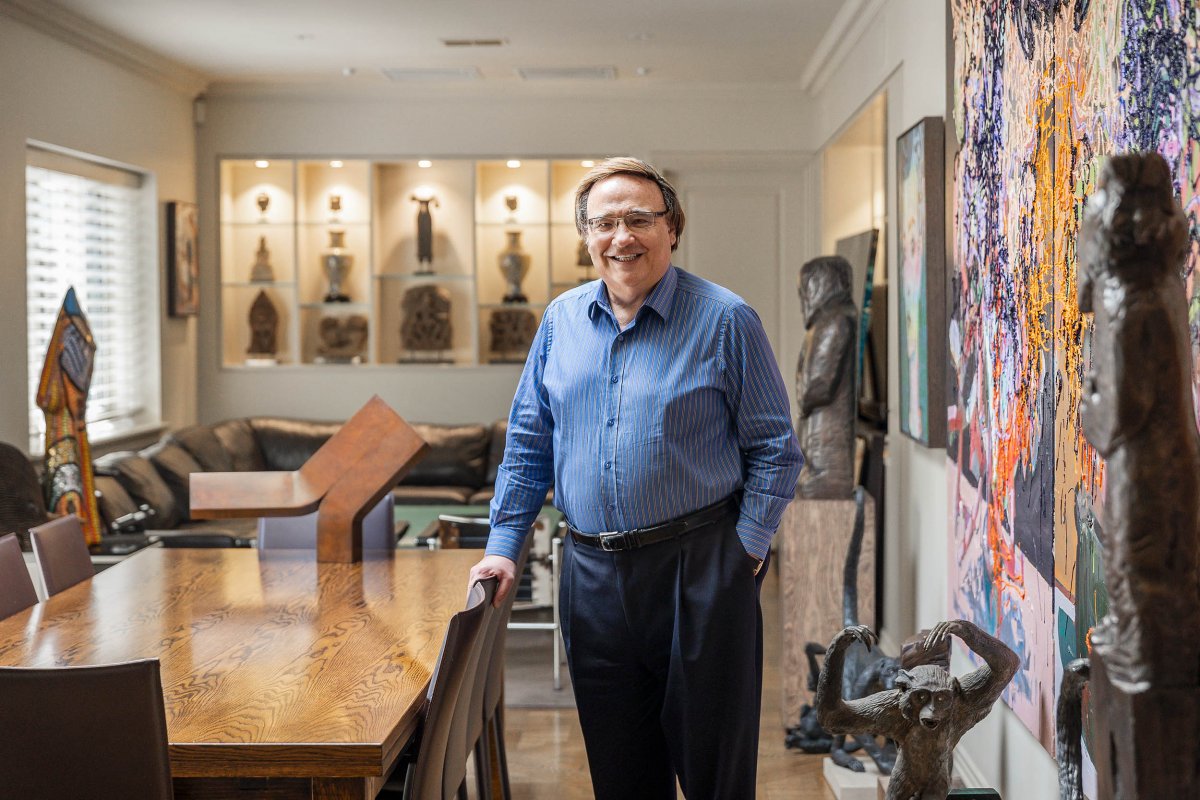
Stepping into Irving’s surprising world
Given the unassuming facade of Irving’s home, you’d be forgiven for having mixed expectations.
But as soon as you step inside, you’ll be greeted by a burst of colour and beauty. The outside world fades away for a moment, as the man himself welcomes you with a friendly smile and warm demeanour.
Irving’s home, doubling as a showroom, is filled with culture and moments frozen in time. From atmospheric portraits, textured landscapes and abstract oil paintings to stately white owl sculptures. You’ll find works by some of Australia’s most renowned artists – like Ben Quilty, Matthew Johnson, Dell Kathryn Barton, Dale Frank and more – all under this one understated roof.
When asked if he has a favourite piece in his collection, Irving looks around with pride in his eyes. ‘Well, I own every piece in here,’ he says. ‘If I didn’t love each and every one, I wouldn’t have bought it.’
And that’s another special something that sets Irving apart from other art dealers: he owns – and loves – everything he sells.
It all started with random decisions
Specialising in the secondary art market, Irving sells only reputable Australian contemporary art that’s been pre-owned.
And after four decades in the business, he’s become the go-to art supplier for many of Melbourne’s leading interior designers – such as David Hicks and Mim Design – as well as art galleries, architects, developers and private collectors.
Looking at him today, with his confident passion and eye for stellar works, you’d never guess that Irving once had absolutely no interest in art.
As we take a seat in a room filled with canvases and sculpted artwork of all sizes, he shares his origin story.
‘When I was in uni,’ he begins. ‘My friend suggested I take an art course to fill my credits, so I took his advice. But not because I had any interest in art. Rather, it was because he said the course was taught in a dim-lit lecture hall where they showed slides – and that if I wanted to, I could sleep. And that sounded great to me!’ he laughs.
This was the first random moment that, in the grand scheme of things, planted the seed for what was to come.
A few years later, Irving went to the USA for a holiday – and made another impromptu decision that would soon change his life.
‘At the end of my trip, I had $1,000 spending money left over. So I thought, why not buy something with it? And since artwork was being sold on every street corner in New York, that’s what I chose.’
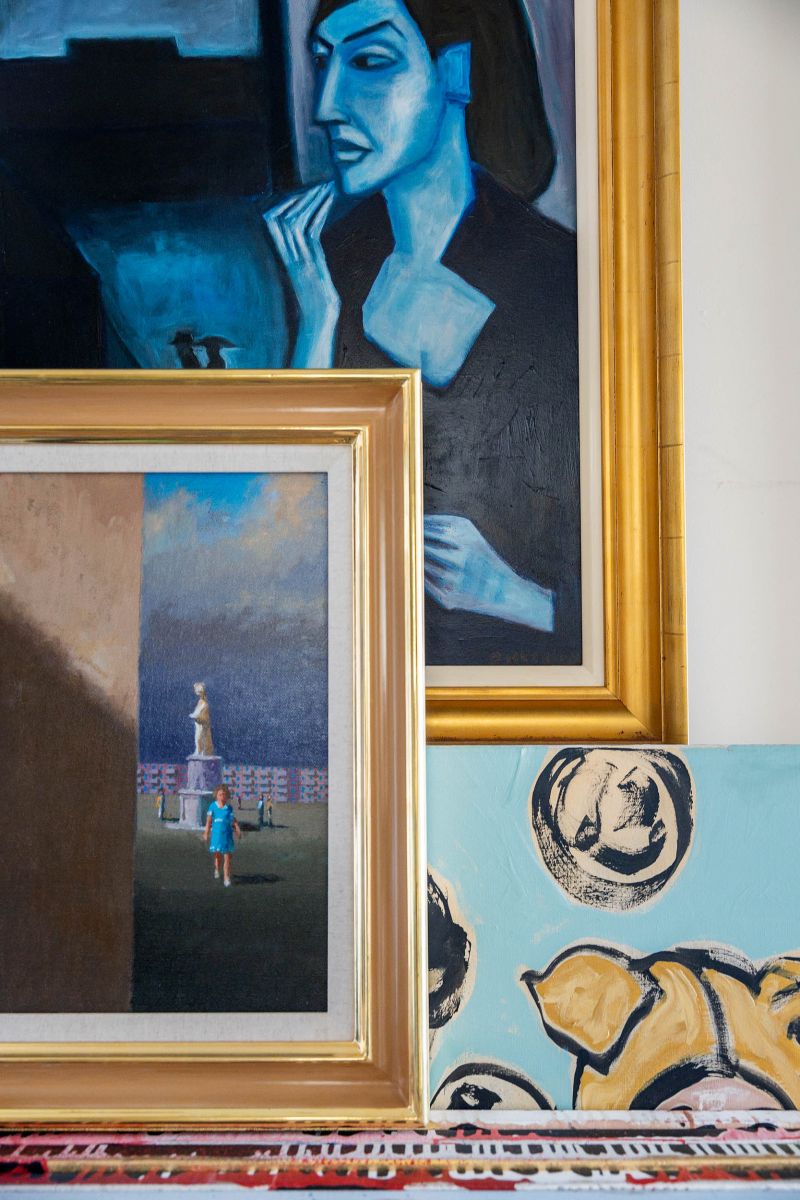
Finding the happy medium
Armed with his new-found knowledge of certain artists like Salvador Dali and Marc Chagall – thanks to his art course – Irving ended up buying ‘a few things’ on those New York streets.
His plan? To come back to Australia and sell them.
How? And to who? He had no idea.
So he started approaching other art dealers, and from there, discovered a love for the secondary art market. And that’s where he’s stayed ever since.
To Irving, pre-owned work is extremely interesting – and sometimes, rich with history.
‘You know all those works that come up for sale in major auction houses both in Australia and overseas, like Sotheby’s and Christie’s? They’ve all been owned before and there’s no stigma attached to that.
‘In fact, it’s better,’ he adds. ‘Because the work has a provenance: who owned it, where it came from, which important collection it’s been in – and buyers appreciate that. There’s a story.’
Although Irving started off by selling international artists’ works, he soon switched his focus to Australian art due to the demand. Most of the art in his collection today is by Aussie artists who have exhibited in state galleries, and who were finalists or winners of the Archibald Prize.
‘Australians tend to only be interested in Australian artwork,’ Irving notes. ‘They just want to support Australian art and artists.’
Getting a sign from above
After that trip to the States, Irving’s art business was really only a hobby. But it took 10 years – and a big blow – before he finally got serious about it.
‘The company I was working for went into receivership. And I thought to myself, you know what, it’s a sign. So instead of looking for another job, I decided to focus on my art business full time.’
Seeing Irving so at home with his art collection, it’s clear he has no regrets.
So what does he love most about his work now?
‘I love meeting the people, I love doing deals,’ he answers enthusiastically. ‘People ask me, are you working today, or are you working on the weekend? Well, I say, if somebody calls, I’m working!’
Something else that fuels his passion? Helping people get quality art that they love – at good value.
‘I try and sell works for what they’re actually worth. Not necessarily the retail price,’ he explains. ‘Which means most of the time, I sell artworks for 30–50% below what you might pay for a new work in a gallery. And that resale value holds.’
Irving’s role in the market allows him to support art buyers and sellers. But as much as he loves helping sellers get a good price for their art, he says it’s not always just about trading for profits.
‘I get artworks from people who have collected them over the years. Sometimes the art just doesn’t suit them anymore. Or other times, people move houses, and their new place doesn’t have enough walls. So, sometimes it’s not about the money.’
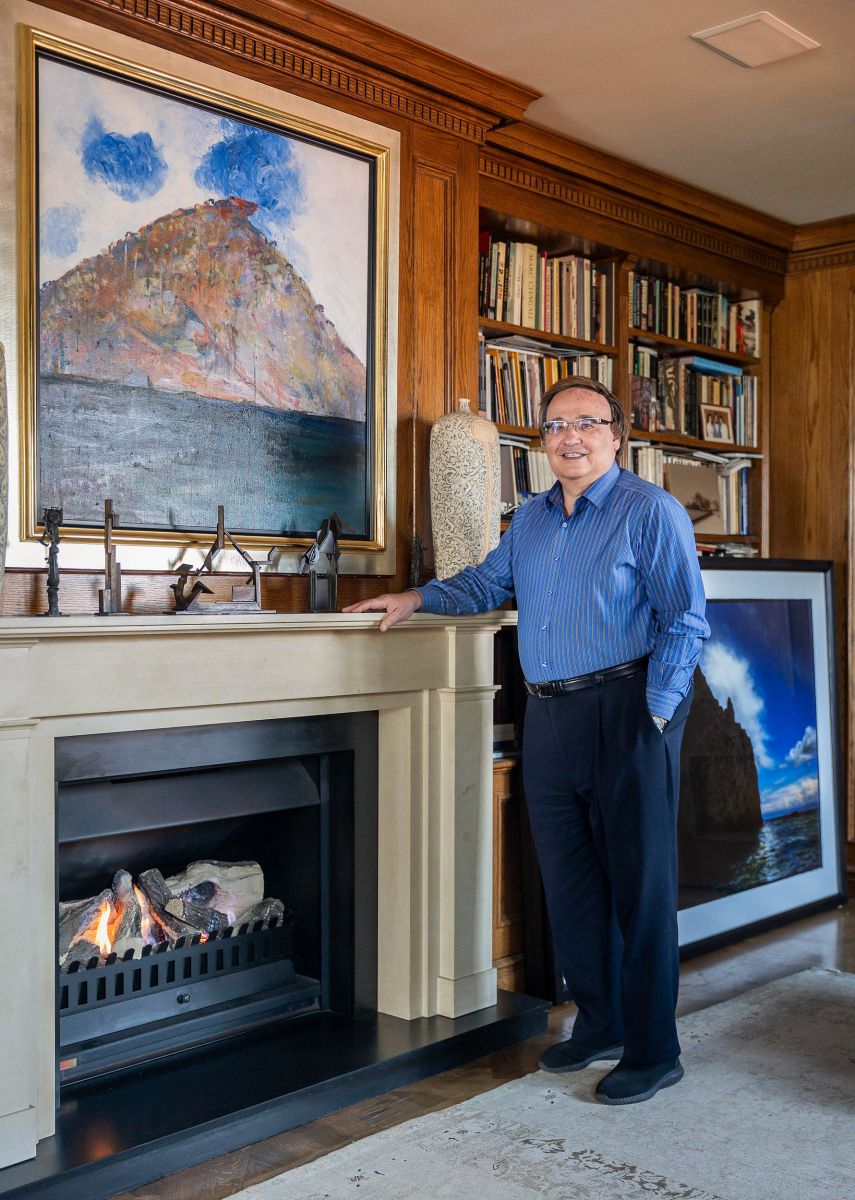
In art choices, go big when you can
Irving may not be an artist himself – ‘I have two left hands,’ he says with a chuckle – but he certainly knows what captivates him.
‘I like contemporary art,’ he says, nodding at his extensive contemporary art collection.
‘It’s the splash of colour. It’s interesting. And it needs no explanation,’ he adds. ‘It’s like a great work of architecture. You can’t explain it. It just looks good. You connect with it. And you feel comfortable with it.’
So what advice would he give to someone who’s looking to invest in an artwork for their space?
‘Bigger is almost always better,’ Irving effuses.
‘Choose the biggest artwork that fits the space. Because if you pick something small, then you might think, gee, I could use something next to it. Then the wall ends up looking busy.
‘Every space you look at, a bigger work almost always looks better,’ he says.
His next piece of advice? Go for the best painting you can afford by an artist that has a strong secondary market.
‘It’s like with property,’ Irving explains. ‘If it’s a matter of a few thousand dollars’ difference between two options, that extra bit of money will be insignificant in a few years’ time. So, if you can afford it, and if you like it, go for a more reputable or recognised artist.
‘Invest in work with great quality and artists with a reputation. Work that can be sold and resold. Because for the extra you’re spending, you’ll get all that money back and more when you sell the work.’
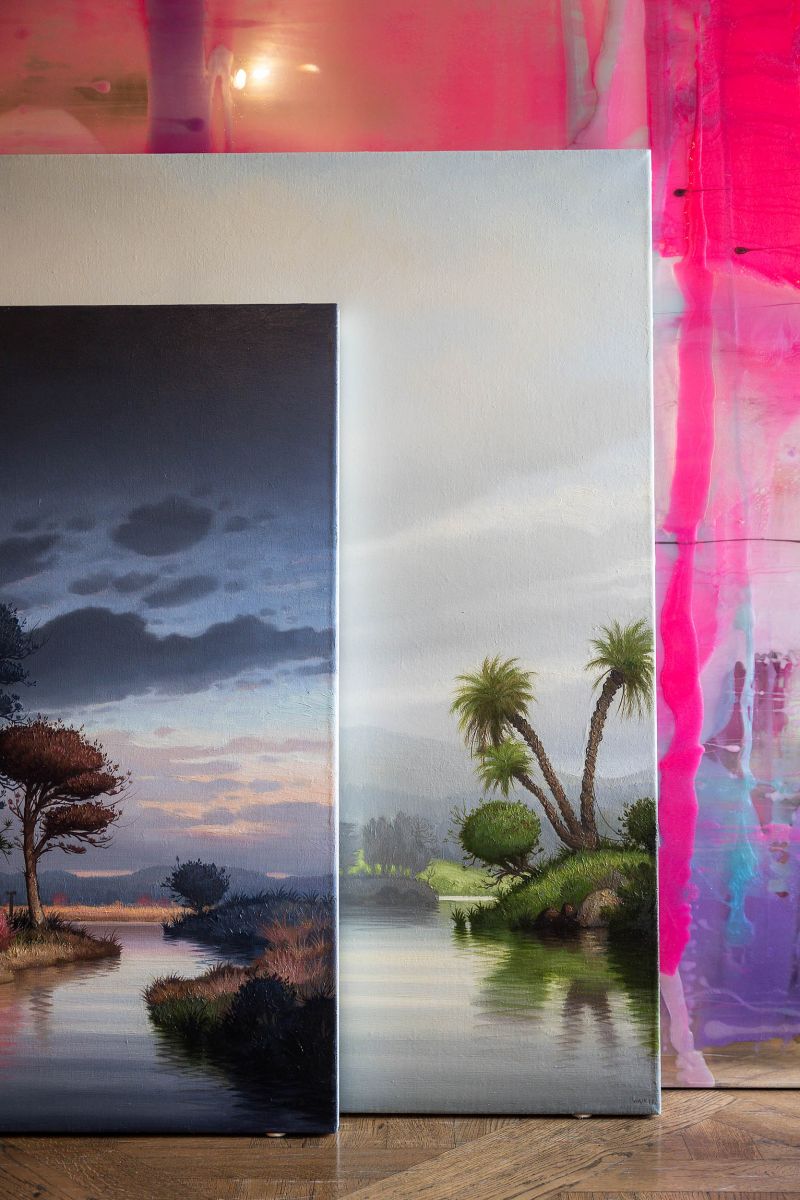
A legacy in the community – and family
Having been in the business for over 40 years, Irving is well known in the community. Both for his beautiful art collection – and generosity.
Local organisations often approach Irving for artwork donations when they do charity auctions or fundraising. And his answer is always a resounding ‘yes’.
‘I just love to help,’ he says simply.
That’s his impact on the community. But what about his impact on his nearest and dearest?
‘My children, Ellie and Josh, love it. They grew up with art around them. And they were used to it, so I never had to worry about them scratching or damaging anything. They also learnt what they liked and didn’t like from a young age. They would ask me lots of questions about the business and the stories behind some of the pieces.
‘And I’ve always involved them in the business. Like, they helped me move things around,’ Irving adds, laughing.
So, the million-dollar question: Will Irving’s children take the reins on his business one day?
Irving’s face softens. ‘Oh, they would love to, but it wouldn’t be easy.
‘The hardest thing is knowing the value of individual pieces,’ he says. ‘How do you teach someone to recognise that something is a bargain at $100,000 – while another is too expensive at $1,000? It’s a skill picked up over many decades.’
That’s definitely something to ponder. But perhaps, they too would make a trip overseas one day, come back with a few pieces to sell – and begin their own journey?
At that, Irving laughs. ‘Maybe. Maybe they would.’
